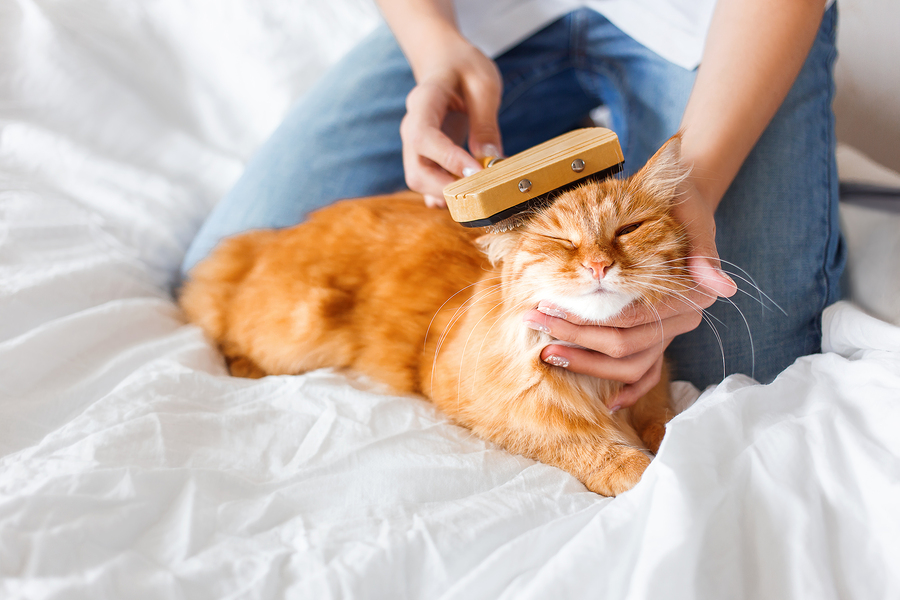This post may contain affiliate links. We are compensated for referring customers to our affiliate partners.
Nothing is worse than hearing your cat start the process of hacking up a hairball. Whether it’s 2-in-the-morning or 5-in-the-evening, when you hear the cough, you know what’s coming.
What Are Hairballs And Why Does My Cat Have Them?
Though it’s called a hairball, it really doesn’t come out in a ball-shape. Hairballs are often long and tube-shaped with a strong resemblance to the color of your kitty cat’s fur. You see them on the floor and in the most inconvenient places and if you’re lucky, you’ll avoid stepping on them in the middle of the night or first thing in the morning.
Hairballs are a result of the excellent grooming habits of your cat. As your cat cleans his fur, little hook-like structures on his tongue pick up the loose and dead hair on his coat. The hair is swallowed and typically passes through the digestive system. But for the hair that stays in his stomach, a hairball can form and he will up-chuck the mass to get rid of it. Cats with longer hair and those who are compulsive groomers tend to swallow more fur and develop more hairballs than short-hair breeds.
At-Home Hairball Helpers
Though hacking up a hairball is pretty normal for your cat, it can be unnerving to hear due to the gagging and retching that precludes the expulsion. Of course, if you notice any other symptoms such as hacking without producing a hairball, lethargy, lack of appetite, constipation, or diarrhea, contact your vet to make sure that there is not an additional problem with your kitty.
Because you love your cat, you want to help her when she has a problem.
If your cat spends a lot of time hacking up hairballs, you want to do whatever you can to lessen the frequency and help her pass the hair more quickly.
The best thing that you can do to help your cat is to brush her every day. This will take up some of the dead and loose hair so that she doesn’t ingest it while grooming. Some of the home remedies that others have tried with success include:
- Mixing a teaspoon of olive or corn oil into your cat’s food once a week
- Wiping down her coat with a hypoallergenic, fragrance-free baby wipe
- Adding ½ teaspoon of real butter to food once a day for a week
- Adding a tablespoon of canned pumpkin (not pie filling) to her daily diet
Though these are all meant to keep the hairball moving along and through the digestive track, be sure talk to your vet before trying anything new.
Are Hairball Remedies Good To Use?
There are several remedies on the market that claim to prevent hairballs in your cat’s digestive system. Many of them are petroleum-based with the intention to lubricate the hair so it will pass through their system easier. Before you try any product such as this, talk to your vet as research has found that many of these brands cause more harm than good.
Hairball Control Cat Food Formulas
There are several brands of cat food that are now marketed to owners of hairball-hawking kitties. They mostly feature a high volume of fiber and the hope is that the fiber will keep things moving along in the digestive tract. Eukanuba makes an Indoor Hairball Relief cat food that many owners feel does a good job in keeping kitty hack-free. Chicken is the first ingredient on the list, followed by powdered cellulose to keep things moving, vitamins and minerals from A to Zinc, and plenty of Omega 3 and 6.
Nutro’s Ultra Hairball Control has the same high quality meat first on the list, but adds pea protein, potatoes, and brown rice to provide lots of good fiber. It also contains dehydrated alfalfa meal, which has plenty of zinc, iron, manganese, vitamins A and C, and chlorophyll; all very beneficial to cats nutrition.
Can Grain Free Cat Food Help?
There has recently been a conversion to grain-free cat food for those cats who vomit frequently. Since cats are natural meat (protein) eaters, a diet that includes grains (carbohydrates) can cause a change to the good bacteria in their intestines. These changes might contribute to the reason why your cat has such a difficult time passing the hair through their system.
Grain free cat food means food that is absent of corn, wheat, rice, and soy. The main ingredients are meat.
Brands By Example
Wellness makes several varieties of grain-free cat food that include plenty of meat, from beef to venison, chicken to fish. They also include taurine, excellent for heart and eye health. Some varieties include peas or pea fiber, which are not grains but yet serve the same purpose of being a natural filler.
By Nature’s Grain Free Chicken & Potato adds carrots to the mix instead of peas, which provides more nutritional value for your cat. The Honest Kitchen has a grain free turkey or chicken grain free cat food that is created from human-grade food sources and includes pumpkin, an excellent source of fiber and nutrients for your cat.
The Constant Groomer
Your cat is a perfectionist, hence his immaculate grooming. So why not be a perfectionist when it comes to his food? Going with a hairball formula cat food, or trying a grain free cat food, can be beneficial to help your furry friend when it comes to the easy elimination of hair balls. Here’s to good grooming and less mess.



